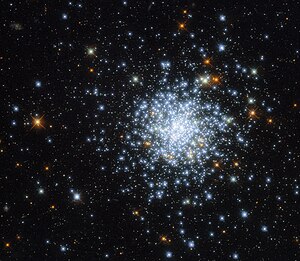NGC 2164
 | |
| Aufnahme mittels Hubble-Weltraumteleskop | |
| AladinLite | |
| Sternbild | Schwertfisch |
| Position Äquinoktium: J2000.0 | |
|---|---|
| Rektaszension | 05h 58m 56,2s [1] |
| Deklination | −68° 30′ 57″ [1] |
| Erscheinungsbild | |
| Helligkeit (visuell) | 10,3 mag [2] |
| Winkelausdehnung | 2,5' [2] |
| Physikalische Daten | |
| Zugehörigkeit | Große Magellansche Wolke |
| Masse | 15.000 M☉ |
| Alter | 100 Millionen Jahre |
| Geschichte | |
| Entdeckt von | James Dunlop |
| Entdeckungszeit | 27. September 1826 |
| Katalogbezeichnungen | |
| NGC 2164 • Dun 194 • ESO 57-SC062 • GC 1356 • h 3011 • | |
NGC 2164 ist ein offener Sternhaufen im Sternbild Dorado in der Großen Magellanschen Wolke. Das Objekt wurde am 27. September 1826 von James Dunlop entdeckt.[3]
Der Sternhaufen hat eine Gesamtmasse von rund 15.000 Sonnenmassen und ist vor etwa 100 Millionen Jahren entstanden.[4]
Weblinks
Einzelnachweise
- ↑ NASA/IPAC EXTRAGALACTIC DATABASE
- ↑ a b SEDS: NGC 2164
- ↑ Seligman
- ↑ Chengyuan Li, Richard de Grijs, Licai Deng, Antonino P. Milone: Discovery of Extended Main-sequence Turnoffs in Four Young Massive Clusters in the Magellanic Clouds. In: Astrophysical Journal. Band 844, Nr. 2, 2017, bibcode:2017ApJ...844..119L (englisch).
Auf dieser Seite verwendete Medien
Autor/Urheber:
Credit:
ESA/Hubble & NASA, J. Kalirai, A. Milone, Lizenz: CC BY 4.0Cluster in the Cloud
This Picture of the Week shows an open cluster known as NGC 2164, which was first discovered in 1826 by a Scottish astronomer named James Dunlop. NGC 2164 is located within one of the Milky Way galaxy's closest neighbours — the satellite galaxy known as the Large Magellanic Cloud. The Large Magellanic cloud is a relatively small galaxy that lies about 160 000 light-years from Earth. It is considered a satellite galaxy because it is gravitationally bound to the Milky Way. In fact, the Large Magellanic cloud is on a very slow collision course with the Milky Way — it’s predicted that they will collide 2.4 billion years from now.
The Large Magellanic Cloud only contains about one hundredth as much mass as the Milky Way, but it still contains billions of stars. The open cluster NGC 2164 is in good company in the Large Magellanic Cloud — the satellite galaxy is home to roughly 700 open clusters, alongside about 60 globular clusters. This image of NGC 2164 was taken by the NASA/ESA Hubble Space Telescope’s Wide Field Camera 3 (WFC3), which has previously imaged many other open clusters, including NGC 330 and Messier 11.
Credit:
ESA/Hubble & NASA, J. Kalirai, A. Milone
Coordinates Position (RA): 5 58 58.53 Position (Dec): -68° 31' 2.90" Field of view: 2.48 x 2.16 arcminutes Orientation: North is 18.0° right of vertical Colours & filters Band Wavelength Telescope Ultraviolet UV 225 nm Hubble Space Telescope WFC3 Optical U 336 nm Hubble Space Telescope WFC3 Optical I 814 nm Hubble Space Telescope WFC3 Optical H-alpha 656 nm Hubble Space Telescope WFC3.
